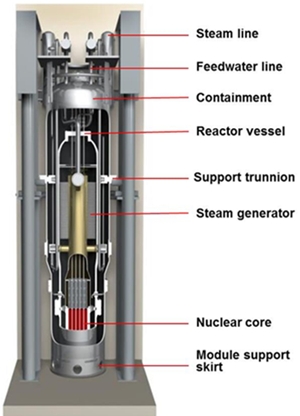On the Road to Small Reactor Design Reviews
Posted by on January 12, 2017
Scott Burnell
Public Affairs Officer
As the NRC starts looking over NuScale’s application to certify the company’s first-of-its-kind “small modular reactor” design, it’s worth looking back at how we got here. It’s also useful to look at the steps we’ll follow going forward in our technical review.
 NuScale’s
application is the first to propose a nuclear power plant designed with
several small reactors instead of one large one. The company has
discussed this approach with us since 2008, using much the same
“pre-application” process followed by makers of traditional large
reactors. These talks helped both the NRC and NuScale understand where
the design might need additional supporting information or alternative
approaches to NRC policies. For instance, NuScale examined how its
design could best meet the NRC’s requirements for staff in the control
room.
NuScale’s
application is the first to propose a nuclear power plant designed with
several small reactors instead of one large one. The company has
discussed this approach with us since 2008, using much the same
“pre-application” process followed by makers of traditional large
reactors. These talks helped both the NRC and NuScale understand where
the design might need additional supporting information or alternative
approaches to NRC policies. For instance, NuScale examined how its
design could best meet the NRC’s requirements for staff in the control
room.
The NRC also used information from NuScale in developing a design-specific review standard. This ensures the agency’s technical staff has specific guidance on the requirements NuScale must meet to get the novel small modular design approved. The standard covers topics such as instrumentation and controls, cooling the reactor core in an emergency, and the materials used for the reactor vessel and steam generator. The NRC published the draft review standard in July 2015 and after public comment, issued the final review standard in August 2016.
The application itself is a collection of electronic files that must be transferred into the NRC’s document database, ADAMS. This process ensures the agency staff can refer to a constant set of information during the review. It also allows the public to view any documents not subject to withholding for security or other reasons. The agency expects all the NuScale application documents will be transferred by mid-January.
 Once the NRC has all the pieces of the NuScale application, the staff
will first check if it contains enough high-quality information for us
to do detailed technical reviews. If it doesn’t, NuScale can provide
supplemental information. If it does and we find the application
acceptable for a full review, we will publish a notice in the Federal Register. We expect to make our acceptance decision by mid-March.
Once the NRC has all the pieces of the NuScale application, the staff
will first check if it contains enough high-quality information for us
to do detailed technical reviews. If it doesn’t, NuScale can provide
supplemental information. If it does and we find the application
acceptable for a full review, we will publish a notice in the Federal Register. We expect to make our acceptance decision by mid-March.
Once we complete our full review and get feedback from the Advisory Committee on Reactor Safeguards, the technical staff will decide whether NuScale’s design is safe and appropriate for U.S. use. If the answer is yes, the staff will offer the Commission a draft rule to add NuScale to the list of approved designs. The public can comment on draft rules to certify new designs.
We expect the design certification review to last about three years, assuming NuScale completely answers any NRC questions in a timely manner. This exacting review ensures the staff can make a fully informed decision that protects public health and safety.
A certified design is considered safe and appropriate for U.S. use; the NRC has certified six reactor designs to this point. Companies interested in using certified designs must apply for separate licenses before reactors can be built and operated.
Public Affairs Officer
As the NRC starts looking over NuScale’s application to certify the company’s first-of-its-kind “small modular reactor” design, it’s worth looking back at how we got here. It’s also useful to look at the steps we’ll follow going forward in our technical review.
 NuScale’s
application is the first to propose a nuclear power plant designed with
several small reactors instead of one large one. The company has
discussed this approach with us since 2008, using much the same
“pre-application” process followed by makers of traditional large
reactors. These talks helped both the NRC and NuScale understand where
the design might need additional supporting information or alternative
approaches to NRC policies. For instance, NuScale examined how its
design could best meet the NRC’s requirements for staff in the control
room.
NuScale’s
application is the first to propose a nuclear power plant designed with
several small reactors instead of one large one. The company has
discussed this approach with us since 2008, using much the same
“pre-application” process followed by makers of traditional large
reactors. These talks helped both the NRC and NuScale understand where
the design might need additional supporting information or alternative
approaches to NRC policies. For instance, NuScale examined how its
design could best meet the NRC’s requirements for staff in the control
room.The NRC also used information from NuScale in developing a design-specific review standard. This ensures the agency’s technical staff has specific guidance on the requirements NuScale must meet to get the novel small modular design approved. The standard covers topics such as instrumentation and controls, cooling the reactor core in an emergency, and the materials used for the reactor vessel and steam generator. The NRC published the draft review standard in July 2015 and after public comment, issued the final review standard in August 2016.
The application itself is a collection of electronic files that must be transferred into the NRC’s document database, ADAMS. This process ensures the agency staff can refer to a constant set of information during the review. It also allows the public to view any documents not subject to withholding for security or other reasons. The agency expects all the NuScale application documents will be transferred by mid-January.

Michael
Johnson, NRC Deputy Executive Director for Operations (right), and
Vonna Ordaz, Acting Director of the Office of New Reactors, (second from
right) receive NuScale’s application from NuScale Chief Nuclear Officer
Dale Atkinson (second from left) and NuScale Vice President for
Regulatory Affairs Tom Bergman (left).
Once we complete our full review and get feedback from the Advisory Committee on Reactor Safeguards, the technical staff will decide whether NuScale’s design is safe and appropriate for U.S. use. If the answer is yes, the staff will offer the Commission a draft rule to add NuScale to the list of approved designs. The public can comment on draft rules to certify new designs.
We expect the design certification review to last about three years, assuming NuScale completely answers any NRC questions in a timely manner. This exacting review ensures the staff can make a fully informed decision that protects public health and safety.
A certified design is considered safe and appropriate for U.S. use; the NRC has certified six reactor designs to this point. Companies interested in using certified designs must apply for separate licenses before reactors can be built and operated.

No comments:
Post a Comment